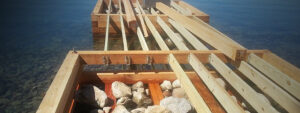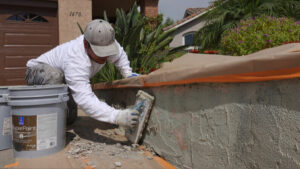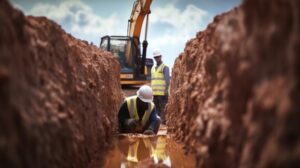Docks withstand a lot of wear and tear, and it is important to keep up with routine maintenance and repairs. Watch out for rotting, rust, cracks, creosote, and wobbling or creaking sounds that can indicate a serious structural problem.

Keeping up with these little issues will extend the life of your dock, saving you money in repair and replacement costs over time. Click Here to learn more.
Warped deck boards are a common issue and can occur due to several reasons. Depending on the severity of the problem, it may be necessary to seek professional assistance for a comprehensive solution. Often, it is not just one board that has become warped but rather the entire deck. This may indicate that the underlying structure has become unstable due to frost heave, soil erosion, or excessively wet conditions.
Wood is a natural material that naturally adjusts to changes in the moisture content of the air. This causes it to expand and shrink in an attempt to reach a balance with its environment. If not properly installed or fastened, this can cause the wood to buckle and bow. Wood that has a tendency to warp includes cedar, redwood and composite lumber. Using wood with a straight grain pattern helps prevent warping.
Deck boards can also become warped due to improper care or cleaning. Using harsh chemicals on the boards can damage the surface and leave it vulnerable to rotting. Termites, carpenter ants and woodpeckers are also known to attack rotting wood and can damage it further. This damage can create a hole through which water can enter and cause further problems with the deck.
Having the proper tools can help you fix your warped deck boards. First, you must identify which portion of your deck needs to be repaired. Once you know this, you can obtain an accurate measurement of the decking to be replaced. Next, you can cut the decking with a circular saw, taking into account its depth. Be sure to wear protective equipment when working with a saw and follow any safety regulations.
Once you have removed the old decking, it is important to replace it with new board sections that are the same in length, colour and material. You should also ensure that the new decking is properly screwed down to the joists. Once the new decking is in place, it can be sealed to protect it from weather and sun damage.
It is possible to repair a single warped deck board, although it is not as cost effective as replacing the whole section of the decking. It is recommended that you contact a professional installer to assess the overall condition of your decking and recommend a solution.
Rust
No matter how beautiful and sturdy your dock was when built, it will eventually need some attention. A floating dock’s constant contact with water makes it prone to damage from boats, waves, and wind. Even treated wood, if exposed to saltwater, will begin to degrade over time. If this happens, it’s important to call a local dock builder or waterfront company to take a look at the damage and determine whether repair or replacement is needed.
A common problem that a professional will notice is rust, either small spots or widespread corrosion on the steel or aluminum that is used for boat dock construction. While a little bit of rust might be easy to patch up, extensive corrosion can compromise the structural integrity of your dock and is therefore a warning sign that it’s time for replacement or major repairs.
Some rust spots can be repaired with simple body filler, but widespread rust will likely require a more in-depth treatment. A professional will typically use a more aggressive chemical solution to remove the existing rust and then spray on a coating of epoxy or other protective chemical. This coating will protect the metal from future damage and ensure that the rust doesn’t spread.
Loose boards on your dock deck might not be a big structural concern, but you don’t want to trip or fall over them either. Similarly, if you see any gaps between dock sections that make it difficult or impossible to walk from one side to the other, this might be an indication of a bigger problem, such as rotting or loose screws.
Another sign that it’s time for a dock repair is the sound of rattling, creaking or grinding noises. Often these are due to loose screws, rotting boards or a combination of the two. While these problems might not be a huge deal right now, they could cause bigger issues down the road, so it’s always best to be proactive and call in a local dock builder to assess the situation. They can also give you a quote for repairing or replacing your dock.
Wood Rot
Wood rot is caused by fungi that break down the parts of the wood that make it strong and stiff. This makes the wood soft and brittle and weakens it. It can destroy a house and the structures within it. If the rotting is severe it can also be a fire hazard.
If you suspect your home may be affected by rot, the best course of action is to have a professional survey carried out. This will identify the type of fungi and how serious the problem is. It will then recommend a course of treatment.
The first step is to eliminate the source of the dampness that’s enabling the fungi to thrive. This will require a complete survey of the property to ensure that all areas are dry and any defects are repaired. This could include a blocked gutter, damaged roof covering or an inadequate damp proof course (DPC). It’s essential that the surveyor identifies all sources of moisture to be sure the rot is stopped dead in its tracks.
Once the source of moisture has been eliminated, the timbers that have been affected can be treated. This will include removing any spores and hyphae, cutting back the infected timber to at least 500mm beyond the last signs of infection and sterilising all affected areas. This can be a daunting job for a homeowner, but is vital to ensuring the safety and security of the building.
In most cases, rot in wood is a result of poor maintenance rather than design flaws. Missing a painting cycle, failing to clean gutters or failing to caulk around windows and doors can allow water to seep in, waking up decay organisms that can turn wood into a mushy mess.
If the rot is limited to just one area of timber, it may be possible to repair it using a wood filler. However, if the damage is extensive and the fungus has already spread to other areas of the frame, the whole area will need replacing. If attempting to repair the rot yourself, it’s a good idea to start with a small section of timber and work your way up to more damaged areas as you gain confidence and experience. It’s also important to follow the materials instructions closely when applying filler and wood hardeners.
Cracks
It’s important to catch dock damage early before it becomes a bigger problem. Whether it’s a crack in the foundation or a section of the dock that sinks, you need to address these issues right away. This is especially true if the cracks are in load-bearing areas of the structure. These problems can lead to significant and expensive structural repairs. Depending on the severity of the damage, it may be best to hire a professional to ensure the safety of the dock and those using it.
Wood rot and rust are two common issues that can be found on most docks. Both of these can be repaired fairly easily if they’re caught in time. If the rotting has gone too far, however, then it’s best to get a new dock. This will prevent further rot, and it’s also much safer to use.
Another issue that can be fixed fairly easily is rusty hardware on the dock. The constant turbulence of the water and the harsh thuds of boats motoring into it can cause a lot of wear and tear on the equipment on your dock. This is a great opportunity to upgrade to better and more durable hardware.
A common problem that can be difficult to fix is a crack in the foundation of the dock. This can be extremely dangerous if it’s in the load-bearing sections of the dock. This type of crack can compromise the structural integrity of the entire dock, so it’s important to have it addressed immediately. A professional can help to determine if the crack is serious and needs to be replaced or if it’s something less severe that just requires a sealant. Depending on the extent of the repair, you may be able to do it yourself, but it’s always best to contact a professional if you’re unsure of what to do.

